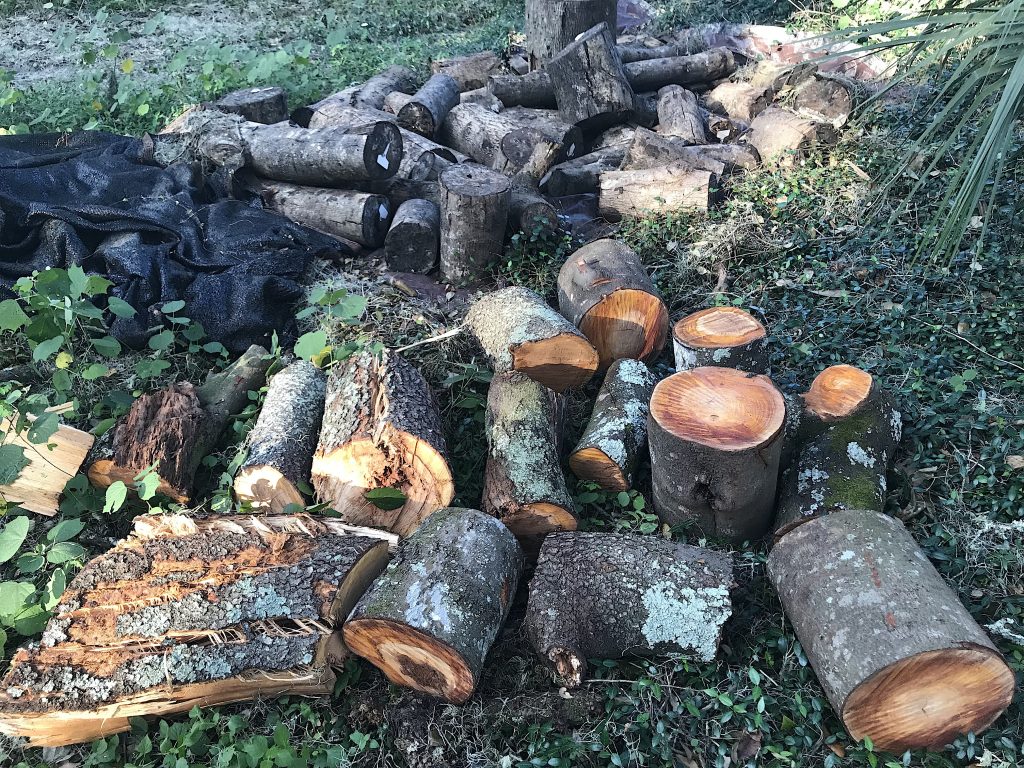
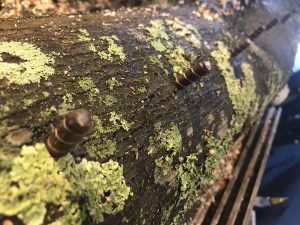
Inoculation maple with a line of lion’s mane plugs. Photo by Green Deane
Don’t throw away hurricane wood! Above is plan A and plan B. In the background is a Plan A a ton of maple rescued from a lawn last summer and inoculate with several different mushroom species. Plan B is a few hundred pounds of Ian-downed oak in front that I will inoculate this week with lion mane spoes. There are several ways to grow mushrooms. I prefer pounding plugs into chunks of wood, a year or two later you get a heck of a lot of edible mushrooms. It takes plugs, a drill, wax and patience. Half-inch plugs are hammered into shallow drill holes then waxed over. The fungus grow through the wood and when time and conditions are right fruit. (And during the wait the maple has produce some edible wild fungi on its own.

Classes are held rain or shine (but not during hurricanes.)
Yes, there are foraging classes this weekend, in Sarasota and Gainesville. They were originally scheduled last week but Hurricane Ian got in the way. Last year at this time it was Hurricane Delta. Gainesville might have chanterelles and Sarasota has a cinnamon tree one can get cuttings from. On a classs-related issue. I had to change internet providers from Spectrum to Tmobile as the former did not cover where I moved to near Tampa. As a result email addresses I have used for some 30 years are no longer valid. Spectrum has no means of forwarding the emails. Thus use GreenDeane@gmail. com. to contact me.
Saturday October 8th, Red Bug Slough 5200 S. Beneva Road, Sarasota. 9 a.m.
Sunday October 9th, Boulware Springs Park, 3420 SE 15th St., Gainesville, FL 32641. 9 a.m.
Saturday October 15th, Eagle Park Lake, 1800 Keene Road, Largo, FL 33771. Meet at the pavilion near the dog park. 9 a.m.
Sunday October 16th, Colby-Alderman Park: 1099 Massachusetts Street, Cassadaga. Fla. 32706. 9 a.m.
For more information about the classes, to pre-pay, or to sign up go here.
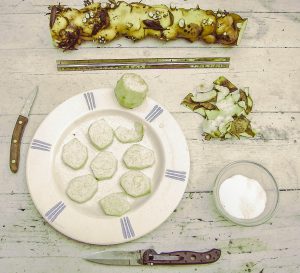
Why don’t you see more Yellow Pond Lilly roots on a plate? Because they are not edible.
Fall is a good time to look for Yellow Pond Lilys. While they fruit rather continuously these pond residents are putting forth a crop now. Plants may not have a brain they can have a strategy, or at least so it seems. Many of them protect their seeds in various ways until they are ready to germinate. The Persimmon Tree comes to mind. The fruit is astringent until the seeds are mature enough to germinate. Then the fruit turns sweet attracting various animals to eat it — those that can taste sweet — and spread the seeds around. The Monstera deliciosa has the same saccharin strategy. The seeds are acrid until ready to germinate then they turn sweet. They have a flavor reminiscent of pineapple and/or wild chamomile. The Yellow Pond Lily works in a similar fashion, almost. It does not turn sweet but the bitterness goes away. Seeds that are not ready to germinate are bitter. As the plant dies the floating seed pod rots over a three-week period. When the seeds are ready to germinate the protective bitterness is removed by enzymatic action. This also makes the seeds edible. Of course we humans can take advantage of the system by collecting the seed pods ourselves and controlling the rotting process. Then we get the seeds and dry them for use in various ways. You can read more about the Yellow Pond Lily here.
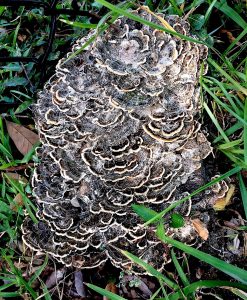
True Turkey Tails. Photo by Green Deane
Turkey Tails are fairly easy to identify medicinal mushroom. For a common type of mushroom I don’t see them that often… two or three times a year. I see False Turkey Tails far more often. More on that later. A seven-year study funded by the National Institutes of Health found Turkey Tail (Trametes versicolor) boosted the immunity in women who had been treated for breast cancer. Researchers at the University of Minnesota and Bastyr University conducted the study in women with stages I-III breast cancer who had completed radiation therapy or chemotherapy. Results showed that immune function was enhanced in the women who took daily doses of Turkey Tail in pill form. They reported that the improved immune response was dose dependent and that none of the subjects suffered any adverse effects. Trametes versicolor can be chewed whole, eaten ground, or made into a tea, or a tincture. The question that always follows such comments is are False Turkey Tails, Stereum ostrea, medicinal? Informally one hears herbalists saying False Turkey Tails can be used but there are few specifics though it has a long herbalism history. A study in 2007 found that water extracts of Stereum ostrea were antibacterial and antifungal. That’s not cancer fighting or immune system stimulating but useful nonetheless. You can read that article here.
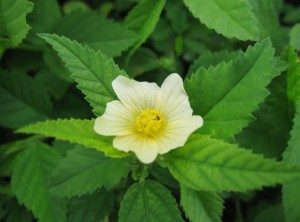
Sida has ephedrine.
Is it Sida (SEE-dah) or is it Sida (SIGH-dah)? Either either it would seem… There are several members of the Sida genus locally and they blossom nearly all year. This weekend, however, Sida cordifolia was particularly happy. Taller and softer than some of the other genusmates, it’s a plant with a little bit of legal history. Plants in the genus tend to have ephedrine in them to varying amounts. Sida cordifolia, however, is the only Sida species mentioned in the Florida Statutes. If you make a pill using the plant it cannot be given to anyone under the age of 18. I doubt the problem is bootleg diet pills but rather youthful experimenting with ephedrine. Adults can apparently do what they want with the plant. S. cordifolia is not native. The species I see the most often is S. rhombifolia, which means diamond shape. The lower part of the leaves of that species do not have teeth on them. We also saw one during our class in Jacksonville Sunday. That might have been Sida acuta. You can read more about Sida here.

You get the USB, not the key.
Changing foraging videos: As my WordPress pages are being updated the video set will go away. They are the same videos I have on You Tube. Some people like to have a separate copy. The DVD format, however, is becoming outdated. Those 135 videos plus 36 more are now available on a USB drive. While the videos were played from the DVDs the videos on the USB have to be copied to your computer to play. They are MP4 files. The 171-video USB is $99. If you make a $99 “donation” using the link at the bottom of this page or here, that order form provides me with your address, the amount — $99 — tells me it is not a donation and is for the USB.

Green Deane Forum
Want to identify a plant? Perhaps you’re looking for a foraging reference? You might have a UFO, an Unidentified Flowering Object, you want identified. On the Green Deane Forum we — including Green Deane and others from around the world — chat about foraging all year. And it’s not just about warm-weather plants or just North American flora. Many nations share common weeds so there’s a lot to talk. There’s also more than weeds. The reference section has information for foraging around the world. There are also articles on food preservation, and forgotten skills from making bows to fermenting food.
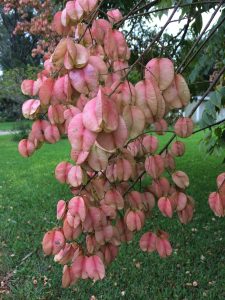
Easy to identify, difficult to remember, the Golden Rain Tree. Photo by Green Deane
And now the Golden Rain Tree… of all the species I have written about over the years this is one I have perhaps the least personal experience with. I have a good reason: I always recognize it at the wrong time of the year when it’s dropping yellow petals in the fall. It is the tree’s springtime boiled shoots that are the most edible part of this species. In the spring, however, the tree is a rather drab Elm- Chinaberry-lookalike. This time of year tree also produces pink boxy seed pods. Usually inside one finds two or four black seeds that are reportedly edible. The problem is they have unrefined erucic acid (oil) which is the same irritating oil in unprocessed rape seed oil which when refined is called Canola. If you have an undisciplined memory like mine the mentioning of erucic acid makes you think of a movie you did not see: Lorenzo’s Oil. The oil, now made from olive oil and erucic aicd, is used to treat ALD, adrenoleukodystrophy. The 1992 movie was based on the true story of parents looking for a treatment for their son. ALD is a genetic disease that causes a metabolic error that in time reduces cognitive function by making an excessive amount of a very-long-chain fat (cerotic acid.) Consumption of the man-made oil can moderate that. Lorenzo himself died of pneumonia in 2008 at age 30.) The seeds I never get around to working with are peppery — Ma Nature is giving us a warning there — and do have a small amount of cyanide. You can read about the tree here.
As for Hurrican Ian, I had power but my internet was spotty for a week, and the creek rose 12 feet, a long ways from the house. At 100 feet elevation water wasn’t an issue, wind was.
This is weekly newsletter #525. If you want to subscribe to this free newsletter you can find the sign-up form in the menu at the top of the page.
To donate to the Green Deane Newsletter click here.


Hurricane Ian did us the great favor of pruning the trees and shrubs that we had been on the verge of calling a tree surgeon for. Unfortunately , the damages were covered by Spanish Moss-across the whole yard. We had NO idea how much work would be entailed until after we started stripping the Spanish Moss off. The best description of waiting on Hurricane Ian’s arrival I read on FB-“Waiting for Ian is like being stalked by a turtle”. I’m going to harvest my Arrowhead Tubers sometime this week or next-been 10 years since planting in 17 gallon pots. Lots of 17 gallon pots. The flower buds just popped out. Should I wait till after flowering is complete, or should I have done so prior to budding, or is this totally a non-issue for the Wapato?